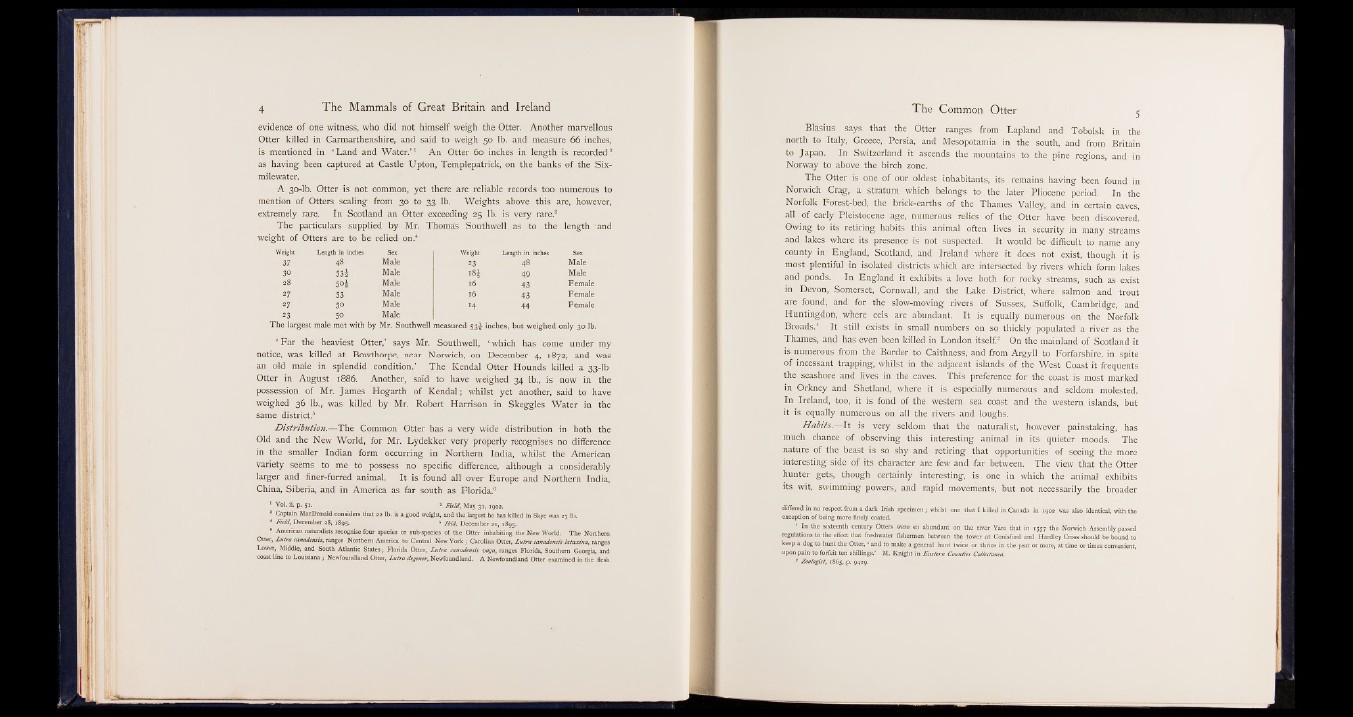
evidence of one witness, who did not himself weigh the Otter. Another marvellous
Otter killed in Carmarthenshire, and said to weigh 50 lb. and measure 66 inches,
is mentioned in ‘ Land and Water.’ 1 An Otter 60 inches in length is recorded2
as having been captured at Castle Upton, Templepatrick, on the banks of the Six-
milewater.
A 30-lb. Otter is not common, yet there are reliable records too numerous to
mention of Otters scaling from 30 to 33 lb. Weights above this are, however,
extremely rare. In Scotland an Otter exceeding 25 lb. is very rare.8
The particulars supplied by Mr. Thomas Southwell as to the length 'and
weight of Otters are to be relied on.4
Weight Length in inches Sex Weight Length in inches Sex
37 48 Male 23 48 Male
30 53i Male l 8$ 49 Male
28 5o£ Male 16 43 Female
27 53 Male 16 43 Female
27 50 Male 44 Female
23 50 Male
The larj rest male met with by Mr. Southwell measured 53^ inches, but weighed only 30 lb.
‘ Fa r the heaviest Otter,’ says Mr. Southwell, ‘ which has come under my
notice, was killed at Bowthorpe, near Norwich, on December 4, 1872, and was
an old male in splendid condition.’ The Kendal Otter Hounds killed a 33-lb
Otter in August 1886. Another, said to have weighed 34 lb., is now in the
possession of Mr. James Hogarth of Kendal; whilst yet another, said to have
weighed 36 lb., was killed by Mr. Robert Harrison in Skeggles Water in the
same district.6
D istribution.—The Common Otter has a very wide distribution in both the
Old and the New World, for Mr. Lydekker very properly recognises no difference
in the smaller Indian form occurring in Northern India, whilst the American
variety seems to me to possess no specific difference, although a considerably
larger and finer-furred animal. It is found all over Europe and Northern India,
China, Siberia, and in America as far south as Florida.6
1 Vol. it p. 51. : 2 Field,, May 31, 1902.
3 Captain MacDonald considers that 22 lb. is a good weight, and the largest he has killed in Skye was 27 lb.
4 Fttld, December 28, 1895. * ibid. December 21, 1895.
6 American naturalists recognise four species or sub-species of the Otter inhabiting the New World. The Northern
Otter, Lutra canadensis, ranges Northern America to Central New York; Carolina Otter, Lutra canadensis lataxina, ranges
Lower, Middle, and South Atlantic States; Florida Otter, Lutra canadensis vaga, ranges Florida, Southern Georgia, and
coast line to Louisiana; Newfoundland Otter, Lutra degener, Newfoundland. A Newfoundland Otter examined in the flesh
Blasiu* says that the Otter tehgesi from Lapland and fjjbolsk in the
north to Italy, Greece, Persia, and Mesopotamia in the south, and from Britain
to Japan. In Switzerland it ascends the ittb'untains to the pine regions, and in
Norway to above the birch zone.
The Otter is one of our oldest inhabitants, its remains having been found in
Norwich Crag, a stratum which belongs to the later Pliocene period. In the
Norfolk Forest-bed, the brick-earths of the Thames Valley, and in certain caves,
all of early Pleistocene age, numerous relics of the Otter have been discovered.
Owing to its retiring habits this animal often lives in security in many streams
and lakes where its presence is not suspected. It would be difficult to name any
county in England, Scotland, and Ireland where it does not exist, though it is
most plentiful in isolated districts which are intersected by rivers which form lakes
and ponds. In England it exhibits a love both for rocky streams, such as exist
in Devon, Somerset, Cornwall, and the Lake District, where salmon and trout
are found, and for the slow-moving rivers of Sussex, Suffolk, Cambridge, and
Huntingdon, where eels are abundant. It is equally numerous on the Norfolk
Broads.1 It still exists in small numbers on so thickly populated a river as the
Thames, and has even been killed in London itself.2 On the mainland of Scotland it
is numerous from the Border to Caithness, and from Argyll to Forfarshire, in spite
of incessant trapping, whilst in the adjacent islands of the West Coast it frequents
the seashore and lives in the caves. This preference for the coast is most marked
in Orkney and Shetland, where it is especially numerous and seldom molested.
In Ireland, too, it is fond of the western sea coast and the western islands, but
it is equally numerous on all the rivers and loughs.
H abits.—It is very seldom that the naturalist, however painstaking, has
much chance of observing this interesting animal in its quieter moods. The
nature of the beast is so shy and retiring that opportunities? of seeing the more
interesting side of its character are few and far between. The view that the Otter
hunter gets, though certainly interesting, is one in which the animal exhibits
its wit, swimming powers, and rapid movements, but not necessarily the broader
differed in no respect from a dark Irish specimen; whilst one that I killed in Canada in 1902 was also identical, with the
exception of being more finely coated.
1 the sixteenth century Otters were so abundant On the river Yare that in 1357 the Norwich Assembly passed
regulations to the effect that freshwater fishermen between the tower at Conisford and Hardley Cross should be bound to
keep a dog to hunt the Otter, ‘ and to make a general hunt twice or thrice in the year or more, at time or times convenient,
upon pain to forfeit ten shillings.’ M. Knight in Eastern Counties Collectanea.
1 Zoologist, 1865, p. 9429.